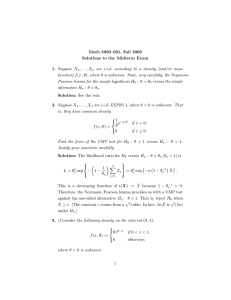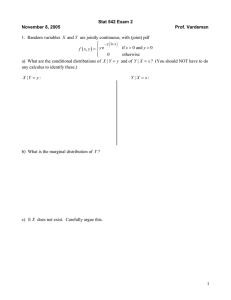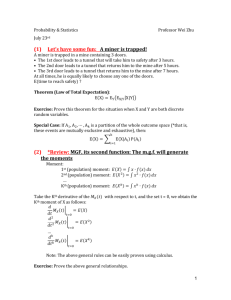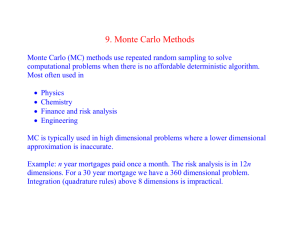Gaussian Random Vectors 1. The multivariate normal distribution
advertisement
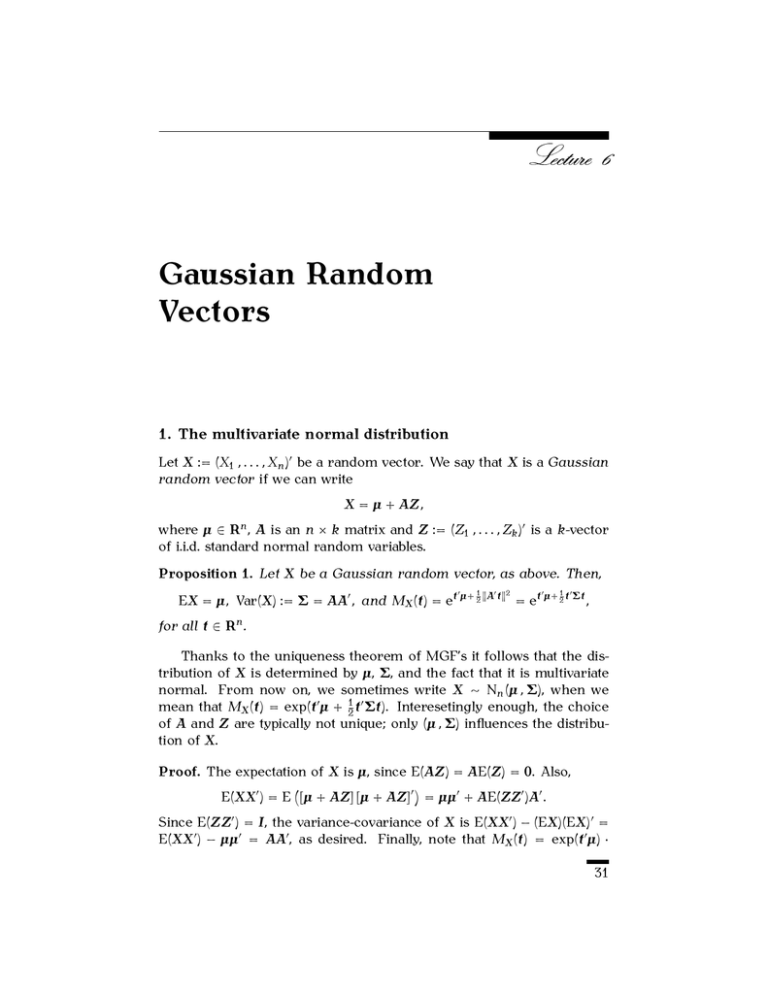
Gaussian Random
Vectors
1. The multivariate normal distribution
Let X := (X1 � � � � � X� )� be a random vector. We say that X is a Gaussian
random vector if we can write
X = µ + AZ�
where µ ∈ R� , A is an � × � matrix and Z := (Z1 � � � � � Z� )� is a �-vector
of i.i.d. standard normal random variables.
Proposition 1. Let X be a Gaussian random vector, as above. Then,
�
1
�
2
�
1 �
EX = µ� Var(X) := Σ = AA� � and MX (�) = e� µ+ 2 �A �� = e� µ+ 2 � Σ� �
for all � ∈ R� .
Thanks to the uniqueness theorem of MGF’s it follows that the distribution of X is determined by µ, Σ, and the fact that it is multivariate
normal. From now on, we sometimes write X ∼ N� (µ � Σ), when we
mean that MX (�) = exp(� � µ + 21 � � Σ�). Interesetingly enough, the choice
of A and Z are typically not unique; only (µ � Σ) influences the distribution of X.
Proof. The expectation of X is µ, since E(AZ) = AE(Z) = 0. Also,
�
�
E(XX� ) = E [µ + AZ] [µ + AZ]� = µµ� + AE(ZZ � )A� �
Since E(ZZ � ) = I, the variance-covariance of X is E(XX� ) − (EX)(EX)� =
E(XX� ) − µµ� = AA� , as desired. Finally, note that MX (�) = exp(� � µ) ·
31
32
6. Gaussian Random Vectors
�
M
establishes the result on the MGF of X, since MZ (�) =
��Z (A �). This
2
exp(�
/2)
=
exp( 21 ���2 ) for all � ∈ R� .
�
�=1
�
We say that X has the multivariate normal distribution with parameters µ and Σ := AA� , and write this as X ∼ N� (µ � AA� ).
�
Theorem 2. X := (X�
1 � � � � � X� ) has a multivariate normal distribution
�
�
if and only if � X = �=1 �� X� has a normal distribution on the line for
every � ∈ R� . That is, X1 � � � � � X� are jointly normally distributed if and
only if all of their linear combinations are normally distributed.
Note that the distribution of X depends on A only through the positive semidefinite � × � matrix Σ := AA� . Sometimes we say also that
X1 � � � � � X� are jointly normal [or Gaussian] when X := (X1 � � � � � X� )� has
a multivariate normal distribution.
Proof. If X ∈ N� (µ � AA� ) then we can write it as X = µ + AZ, we as
before. In that case, � � X = � � µ+� � AZ is a linear combination of Z1 � � � � � Z� ,
whence has a normal distribution with mean �1 µ1 +· · ·+�� µ� and variance
� � AA� � = �A� ��2 �
For the converse, suppose that � � X has a normal distribution for
every � ∈ R� . Let µ := EX and Σ := Var(X), and observe that � � X
has mean vector � � µ and variance-covariance matrix � � Σ�. Therefore,
the MGF of the univariate normal � � X is M� � X (�) = exp(�� � µ + 21 �2 � � Σ�)
for all � ∈ R. Note that M� � X (�) = E exp(�� � X). Therefore, apply this
with � := 1 to see that M� � X (1) = MX (�) is the MGF of a multivariate
normal. The uniqueness theorem for MGF’s (Theorem 1, p. 27) implies
the result.
�
2. The nondegenerate case
Suppose X ∼ N� (µ � Σ), and recall that Σ is always positive semidefinite.
We say that X is nondegenerate when Σ is positive definite (equivalently,
invertible).
Take, in particular, X ∼ N1 (µ � Σ); µ can be any real number and Σ is
a positive semidefinite 1 × 1 matrix; i.e., Σ ≥ 0. The distribution of X is
defined via its MGF as
1 2
MX (�) = e�µ+ 2 � Σ �
When X is nondegenerate (Σ > 0), X ∼ N(µ � Σ). If Σ = 0, then MX (�) =
exp(�µ); therefore by the uniqueness theorem of MGFs, P{X = µ} = 1.
Therefore, N1 (µ � σ 2 ) is the generalization of N(µ � σ 2 ) in order to include
the case that σ = 0. We will not write N1 (µ � σ 2 ); instead we always write
N(µ � σ 2 ) as no confusion should arise.
2. The nondegenerate case
33
Theorem 3. X ∼ N� (µ � Σ) has a probability density function if and
only if it is nondegenerate. In that case, the pdf of X is
�
�
1
1
� −1
�X (�) =
exp − (� − µ) Σ (� − µ)
2
(2π)�/2 (det Σ)1/2
for all � ∈ R� .
Proof. First of all let us consider the case that X is degenerate. In that
case Σ has some number � < � of strictly-positive eigenvalues. The
proof of Theorem 2 tells us that we can write X = AZ + µ, where Z is a
�-dimensional vector of i.i.d. standard normals and A is an � × � matrix.
Consider the �-dimensional space
�
�
E := � ∈ R� : � = A� + µ for some � ∈ R� �
Because P{Z ∈ R� } = 1, it follows that P{X ∈ E} = 1. If X had a pdf �X ,
then
�
1 = P{X ∈ E} =
�X (�) d��
E
But the �-dimensional volume of E is zero since the dimension of E is
� < �. This creates a contradiction [unless X did not have a pdf, that is].
If X is nondegenerate, then we can write X = AZ + µ, where Z is
an �-vector of i.i.d. standard normals and Σ = AA� is invertible; see the
proof of Theorem 2. Recall that the choice of A is not unique; in this
case, we can always choose A := Σ1/2 because Σ1/2 Z + µ ∼ N� (µ � Σ). In
other words,
�
�
�
�
1
X� =
A��� Z� + µ� =
Σ���/2 Z� + µ� := �� (Z1 � � � � � Z� )
(1 ≤ � ≤ �)�
�=1
�=1
1/2
If � = Σ �+µ, then � = Σ−1/2 (� −µ). Therefore, the change of variables
formula of elementary probability implies that
�
�
�Z Σ−1/2 (� − µ)
�X (�) =
�
|det J|
as long as det J �= 0, where
∂�1
···
∂�1
..
J := .
∂��
∂�1
···
∂�1
∂��
A1�1 · · ·
.. = ..
. .
∂��
A��1 · · ·
∂�
�
A1��
.. = A�
.
A���
Because det(Σ) = det(AA� ) = (det A)2 , it follows that det A = (det Σ)1/2 ,
and hence
�
�
1
−1/2
�X (�) =
�
Σ
(�
−
µ)
�
Z
1
(det Σ) /2
34
Because of the independence of the Z� ’s,
6. Gaussian Random Vectors
2
�
�
�
e−�� /2
1
√
�Z (�) =
=
e−� �/2
�/2
(2π)
2π
�=1
for all � ∈ R� . Therefore,
�
�
1
�Z Σ− /2 (� − µ) =
and the result follows.
�
�
1
1
� −1
exp − (� − µ) Σ (� − µ) �
2
(2π)�/2
�
3. The bivariate normal distribution
A bivariate normal distribution has the form N2 (µ � Σ), where µ1 = EX1 ,
µ2 = EX2 , Σ1�1 = Var(X1 ) := σ12 > 0, Σ2�2 = Var(X2 ) := σ22 > 0, and
Σ1�2 = Σ2�1 = Cov(X1 � X2 ). Let
Cov(X1 � X2 )
ρ := Corr(X1 � X2 ) := �
Var(X1 ) · Var(X2 )
denote the correlation between X1 and X2 , and recall that −1 ≤ ρ ≤ 1.
Then, Σ1�2 = Σ2�1 = ρσ1 σ2 , whence
� 2
�
σ1
ρσ1 σ2
Σ=
�
ρσ1 σ2
σ22
Since det Σ = σ12 σ22 (1 − ρ2 ), it follows immediately that our bivariate normal distribution is non-degenerate if and only if −1 < ρ < 1, in which
case
1
ρ
1
−
·
σ 2 (1 − ρ2 )
1 − ρ2 σ1 σ2
1
�
Σ−1 =
ρ
1
1
−
·
2
2
1 − ρ2 σ1 σ2
σ2 (1 − ρ )
Because
�
−1
�Σ �=
�
�1
σ1
�2
− 2ρ
�
�1
σ1
��
�2
σ2
�
+
�
�2
σ2
�2
for all � ∈ R� , the pdf of X = (X1 � X2 )� —in the non-degenerate case
where there is a pdf—is
�X (�1 � �2 )
�
��
�
�
��
� �
� ��
1
1
� 1 − µ1 2
�1 − µ1
� 2 − µ2
�2 − µ2 2
�
=
exp −
− 2ρ
+
�
σ1
σ1
σ2
σ2
2(1 − ρ2 )
2πσ1 σ2 1 − ρ2
4. A few important properties of multivariate normal distributions
35
But of course non-degenerate cases are also possible. For instance,
suppose Z ∼ N(0 � 1) and define X := (Z � −Z). Then X = AZ where
A := (1 � −1)� , whence
�
�
1 −1
�
Σ = AA =
−1 1
is singular. In general, if X ∼ N� (µ � Σ) and the rank of Σ is � < �, then
X depends only on � [and not �] i.i.d. N(0 � 1)’s. This can be gleaned from
the proof of Theorem 2.
4. A few important properties of multivariate normal
distributions
Proposition 4. Let X ∼ N� (µ � Σ). If C is an � × � matrix and � is
an �-vector, then CX + � ∼ N� (Cµ + � � CΣC � ). In general, CΣC �
is positive semidefinite; it is positive definite if and only if it has full
rank �.
In particular, if � is a nonrandom �-vector, then �� X ∼ N(�� µ � �� Σ�)�
Proof. We compute the MGF of CX + � as follows:
�
�
�
MCX+� (�) = E exp � � [CX + �] = e� � MX (�)�
where � := C � �� Therefore,
�
�
�
�
1 �
1 �
�
�
�
MCX+� (�) = exp � � + � µ + � Σ� = exp � ν + � Q� �
2
2
where ν := Cµ + � and Q := CΣC � . Finally, a general fact about symmetric matrices (Corollary 13, p. 17) implies that the symmetric � × �
matrix CΣC � is nonsingular if and only if it has full rank �.
�
Proposition 5. If X ∈ N� (µ � Σ), for a nonsingular variance-covariance
matrix Σ, and C�×� and ��×1 are nonrandom, then CX + � is nonsingular if and only if rank(C) = �.
Proof. Recall that the nonsingularity of Σ is equivalent to it being positive definite. Now CX + � is multivariate normal by the preceding result. It is nondegenerate if and only if CΣC � is positive definite. But
� � CΣC � � = (C � �)� Σ(C � �) > 0 if and only if (C � �) �= 0, since Σ is positive
definite. Therefore, CX + � is nondegenerate if and only if C � � �= 0
whenever � �= 0. This is equivalent to � � C �= 0 for all nonzero vectors
�; that is, C has row rank—hence rank—�.
�
36
6. Gaussian Random Vectors
The following is an easy corollary of the previous proposition, and
identifies the “standard multivariate normal” distribution as the distribution of i.i.d. standard univariate normal distributions. It also states that
we do not change the distribution of a standard multivariate normal if
we apply to it an orthogonal matrix.
Corollary 6. Z ∼ N� (0 � I) if and only if Z1 � � � � � Z� are i.i.d. N(0 � 1)’s.
Moreover, if Z ∼ N� (0 � I) and A�×� is orthogonal then AZ ∼ N� (0 � I)
also.
Next we state another elementary fact, derived by looking only at
the MGF’s. It states that a subset of a multivariate normal vector itself is
multivariate normal.
Proposition 7. Suppose X ∼ N� (µ � Σ) and 1 ≤ �1 < �2 < · · · < �� ≤ � is
a subsequence of 1 � � � � � �. Then, (X�1 � � � � � X�� )� ∼ N� (ν � Q), where
X�1
µ�1
X �1
Σ�1 ��1 · · · Σ�1 ���
.. �
ν := E ... = ... �
Q := Var ... = ...
.
X ��
µ��
X ��
�� ��1
···
�� ���
Proposition 8. Suppose X ∼ N� (µ � Σ), and assume that we can divide
the X� ’s into two groups: (X� )�∈G and (X� )��∈G , where G is a subset of the
index set {1 � � � � � �}. Suppose in addition that Cov(X� � X� ) = 0 for all
� ∈ G and � �∈ G. Then, (X� )�∈G is independent from (X� )��∈G .
Thus, for example, if (X1 � X2 � X3 )� has a trivariate normal distribution and X1 is uncorrelated from X2 and X3 , then X1 is independent
of (X2 � X3 ). For a second example suppose that (X1 � X2 � X3 � X4 ) has a
multivariate normal distribution and: E(X1 X2 ) = E(X1 )E(X2 ), E(X1 X3 ) =
E(X1 )E(X3 ), E(X4 X2 ) = E(X4 )E(X2 ), and E(X4 X3 ) = E(X4 )E(X3 ), then (X1 � X4 )
and (X2 � X3 ) are two independent bivariate normal random vectors.
Proof. I will prove the following special case of the proposition; the general case follows from a similar reasoning, but the notation is messier.
Suppose (X1 � X2 ) has a bivariate normal distribution and E(X1 X2 ) =
E(X1 )E(X2 ). Then, X1 and X2 are independent. In order to prove this we
write the MGF of X := (X1 � X2 )� :
�
1 �
MX (�) = e� µ+ 2 � Σ�
=e
�1 µ1 +�2 µ2
1 2
· exp
�
�
� � ��
1
Var(X1 )
0
�1
(�1 � �2 )
0
Var(X2 )
�2
2
1 2
= e�1 µ1 + 2 �1 Var(X1 ) · e�2 µ2 + 2 �2 Var(X2 )
= MX1 (�1 ) · MX2 (�2 )�
5. Quadratic forms
37
The result follows from the independence theorem for MGF’s (Theorem
6, p. 29).
�
Remark 9. The previous proposition has generalizations. For instance,
suppose we could decompose {1 � � � � � �} into � disjoint groups G1 � � � � � G�
[so G� ∩ G� = ∅ if � �= �, and G1 ∪ · · · ∪ G� = {1 � � � � � �}] such that
X�1 � � � � � X�� are [pairwise] uncorrelated for all �1 ∈ G1 � � � � � �� ∈ G� . Then,
(X� )�∈G1 � � � � � (X� )�∈G� are independent multivariate normal random vectors. The proof is the same as in the case � = 2.
�
Remark 10. It is important that X has a multivariate normal distribution.
For instance, we can construct two standard-normal random variables X
and Y , on the same probability space, such that X and Y are uncorrelated
but dependent. Here is one way to do this: Let Y ∼ N(0 � 1) and S = ±1
with probability 1/2 each. Assume that S and Y are independent, and
define X := S|Y |. Note that
P{X ≤ �} = P{X ≤ � � S = 1} + P{X ≤ � � S = −1}
=
1
1
P{|Y | ≤ �} + P{−|Y | ≤ �}�
2
2
If � ≥ 0, then P{X ≤ �} = 21 P{|Y | ≤ �} + 21 = P{Y ≤ �}� Similarly,
P{X ≤ �} = P{Y ≤ �} if � ≤ 0. Therefore, X� Y ∼ N(0 � 1). Furthermore, X and Y are uncorrelated because S has mean zero; here is why:
E(XY ) = E(SY |Y |) = E(S)E(Y |Y |) = 0 = E(X)E(Y )� But X and Y are
not independent because |X| = |Y |: For instance, P{|X| < 1} > 0, but
P{|X| < 1 | |Y | ≥ 2} = 0� The problem is [and can only be] that (X � Y )� is
not bivariate normal.
�
5. Quadratic forms
Given a multivariate-normal random variable X ∼ N� (0 � I) and an � × �
positive semidefinite matrix A := (A��� ), we can consider the random
quadratic form
QA (X) := X� AX�
We can write A, in spectral form, as A = PDP � , so that
QA (X) = X� PDP � X�
Since P is orthogonal and X ∼ N� (0 � I), Z := P � X ∼ N� (0 � I) as well.
Therefore,
�
�
�
QA (X) = Z DZ =
D��� Z�2 �
�=1
38
6. Gaussian Random Vectors
If A is a projection matrix, then all of the D��� ’s are ones and zeros. In
that case, QA (X) ∼ χ�2 , where � := the number of eigenvalues of A that
are ones; i.e, � = rank(A). Finally, recall that the rank of a projection
matrix is equal to its trace (Corollary 16, p. 16). Let us summarize our
findings.
Proposition 11. If X ∼ N� (0 � I) and A is a projection matrix, then
2
2
X� AX ∼ χrank(A)
= χtr(A)
= χ�2 , where � := the total number of nonzero
[i.e., one] eigenvalues of A.
Example 12. Let
1/�
1/�
1 − 1/�
−1/�
···
−1/� 1 − 1/� −1/� · · · − 1/�
A := .
..
.. �
..
..
..
.
.
.
.
−1/�
−1/� −1/�
···
1 − 1/�
Then we have seen (Example 5, p. 23) that
� � A� =
�
�
�=1
(�� − �
¯ )2
Now let us observe that A has the form
for all � ∈ R� �
A = I − B�
where B := (1/�)1�� . Note that B is symmetric and B2 = B. Therefore,
B is a projection, and hence so is A = I − B. Clearly, tr(A) = � − 1.
Therefore, Proposition 11 implies
the familiar fact that if X1 � � � � � X� are
�
2
i.i.d. standard normals, then ��=1 (X� − X̄)2 ∼ χ�−1
.
�
Example 13. If A is an � × � projection matrix of rank [or trace] �, then
I − A is an � × � projection matrix of rank [or trace] � − �. Therefore,
2 , whenever X ∼ N (0 � I).
X� (I − A)X ∼ χ�−�
�
�
Example 14. What is the distribution of X is a nonstandard multivariate
normal? Suppose X ∼ N� (µ � Σ) and A is a projection matrix. If X is
nondegenerate, then Σ−1/2 (X − µ) ∼ N� (0 � I)� Therefore,
2
2
(X − µ)� Σ− /2 AΣ− /2 (X − µ) ∼ χrank(A)
= χtr(A)
�
1
1
for every � × � projection matrix A. In particular,
(X − µ)� Σ−1 (X − µ) ∼ χ�2 �
which can be seen by specializing the preceding to the projection matrix
A := I. Specializing further still, we see that if X1 � � � � � X� are independent
5. Quadratic forms
normal random variables, then we obtain the familiar fact that
�
� �
�
X � − µ� 2
∼ χ�2 �
σ�
where µ� := EX� and
σ�2
�=1
:= Var(X� ).
39
�


